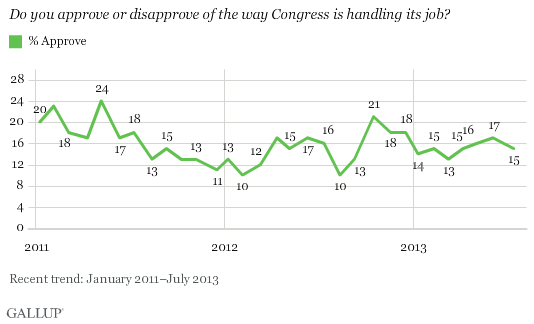WASHINGTON, D.C. -- Americans remain down on Congress, with 15% approving and 78% disapproving of the job it is doing. This approval rating is similar to the low levels seen this year, and is five percentage points above the all-time low of 10%, last recorded in August 2012.

Congress' approval rating remains stagnant at the low end of Gallup's historical trend. Approval has averaged 15% so far this year, far below the overall 33% average rating for the entire trend since 1974. The average for 2013 to date ties with 2012 for the lowest annual average on record. More generally, Americans' views of Congress have been depressed for the past few years, averaging 17% in 2011 and 19% in 2010. The highest yearly average was 56% in 2001, due to a spike in congressional approval after the 9/11 terrorist attacks.
Democrats Give Congress a Slightly Higher Rating Than Republicans
Democrats are still slightly more likely than Republicans and independents to approve of Congress. Twenty-one percent of Democrats approve, compared with 12% of Republicans and 14% of independents.
More broadly, Americans in all three groups have been displeased with Congress since it came under divided control after the 2010 midterm elections, with the exception of a temporary spike in Democrats' ratings prior to the 2012 elections.

Implications
Congress' approval rating is at a dismal 15%, just five points above the all-time low. Some members of Congress are aware of the institution's poor standing with the American public and say they are trying to address it. For instance, Senate Majority Leader Harry Reid in a speech earlier this week mentioned that partisan gridlock and not getting things done are driving Congress' low approval -- factors consistent with Gallup's recent findings on the top reasons Americans disapprove of Congress. Reid cited these factors to bolster his argument for a "nuclear option," which would have significantly reformed the ways in which Senate filibusters have delayed confirmation of President Barack Obama's executive-branch nominees.
While the Senate reached a bipartisan agreement to avoid the nuclear option, Congress likely will need to reach many more bipartisan agreements in the months ahead to improve its approval rating. Congress' approval rating could benefit if it passes immigration reform, which the public broadly supports. Additionally, Congress could boost its standing with the public by avoiding partisan acrimony this fall during the debate to raise the debt limit.
Survey Methods
Results for this Gallup poll are based on telephone interviews conducted July 10-14, 2013, with a random sample of 2,027 adults, aged 18 and older, living in all 50 U.S. states and the District of Columbia.
For results based on the total sample of national adults, one can say with 95% confidence that the margin of sampling error is ±3 percentage points.
Interviews are conducted with respondents on landline telephones and cellular phones, with interviews conducted in Spanish for respondents who are primarily Spanish-speaking. Each sample of national adults includes a minimum quota of 50% cellphone respondents and 50% landline respondents, with additional minimum quotas by region. Landline and cell telephone numbers are selected using random-digit-dial methods. Landline respondents are chosen at random within each household on the basis of which member had the most recent birthday.
Samples are weighted to correct for unequal selection probability, nonresponse, and double coverage of landline and cell users in the two sampling frames. They are also weighted to match the national demographics of gender, age, race, Hispanic ethnicity, education, region, population density, and phone status (cellphone only/landline only/both, and cellphone mostly). Demographic weighting targets are based on the March 2012 Current Population Survey figures for the aged 18 and older U.S. population. Phone status targets are based on the July-December 2011 National Health Interview Survey. Population density targets are based on the 2010 census. All reported margins of sampling error include the computed design effects for weighting.
In addition to sampling error, question wording and practical difficulties in conducting surveys can introduce error or bias into the findings of public opinion polls.
View methodology, full question results, and trend data.
For more details on Gallup's polling methodology, visit www.gallup.com.
